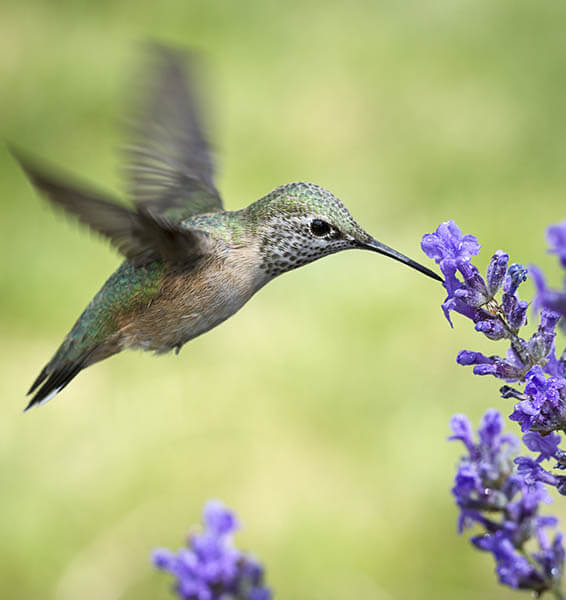Listen to hear a scientist describe the unique features of a hummingbird, including extra fast wing speed and a quick metabolism, that make them expert flyers, and learn how to attract them to a garden.

Subject: Science
Grade level: Elementary
Picture this: a gardener hears a humming sound in a garden full of flowers. What is the source of the noise? It might be a hummingbird! These tiny creatures fly so fast that they can be hard to see. Listen to hear a scientist describe the unique features of a hummingbird, including extra fast wing speed and a quick metabolism, that make them expert flyers, and learn how to attract them to a garden.
Hovering Hummingbirds
Listening Guide
BEFORE LISTENING: Begin the lesson by asking students what they know about how living things get energy. Use the following questions to guide the discussion: How do you get energy to run and play? What happens to your energy level when you’re hungry? Be sure to explain that living things get energy from food. The more energy a living thing uses, the more food it needs to eat. Some animals need to eat a lot of food because they use so much energy staying alive.
Preview the vocabulary by reading aloud the terms and their definitions. Ask students to also listen for the words “metabolism” and “omnivore.” After a first listen, explain that “metabolism” and “omnivore” are terms that have to do with how a living thing gets energy. Metabolism describes the process a living thing goes through to break food into energy. An omnivore is a living thing that eats both plants and animals. Ask students to explain how the terms are used in the audio story.
Introduce the story: Say to students: Have you ever seen a hummingbird? What do you know about hummingbirds? Now you will hear an audio story about hummingbirds and learn some amazing facts about these birds.
DURING LISTENING: Introduce the listening organizer to support students in understanding the story while listening to it. This is intended to guide students in taking notes to help them focus their listening.
The Fact/Question T-Chart will guide students while listening as they take notes on facts about hummingbirds. (Sample responses: A. The bee hummingbird is the smallest bird in the world. B. How much does a bee hummingbird weigh?)
AFTER LISTENING: Ask students to respond to the listening comprehension questions and share their responses with a partner, small group, or the whole class.
Take time for student reflection on the audio story. Use the discussion questions to focus students about interesting facts and features of hummingbirds.
Paired Text: Use the Wonderopolis article [Do Hummingbirds Really Hum?](https://www.wonderopolis.org/wonder/do-hummingbirds-really-hum) to pair with this audio story. Ask students to compare and contrast the information they learned from the audio story with the information they learn from the article.
Assignment Resources
Listening Comprehension Questions:
- Where can you find bee hummingbirds, according to the audio story?
- What makes hummingbirds such good flyers?
- How many flowers do hummingbirds visit in one day?
Classroom Discussion Questions:
- How do hummingbirds help the environment? Use details from the audio story to support your answer.
- Hummingbirds like trumpet-shaped and cone-shaped flowers. How could you use this information to design a bird feeder for hummingbirds?
Vocabulary Words:
appetite (noun) – the need for food or drink
expert (noun) – a person who knows a lot about a topic
extreme (adjective) – very great
fascinate (verb) – to maintain the attention of
nectar (noun) – a sweet liquid found in certain flowers
precision (noun) – the quality of being accurate
Quiz Answers: 1>D / 2>B / 3>C / 4>A
Listen to the full podcast episode
Text materials provided by Listenwise

